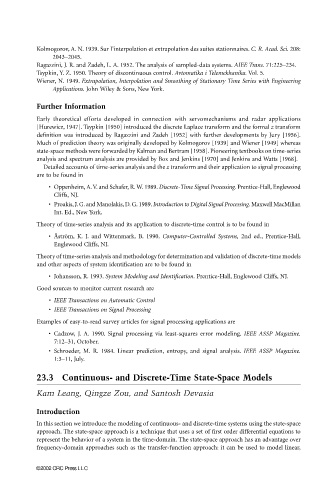Page 732 - The Mechatronics Handbook
P. 732
0066_Frame_C23 Page 40 Wednesday, January 9, 2002 1:55 PM
Kolmogorov, A. N. 1939. Sur l’interpolation et extrapolation des suites stationnaires. C. R. Acad. Sci. 208:
2043–2045.
Ragazzini, J. R. and Zadeh, L. A. 1952. The analysis of sampled-data systems. AIEE Trans. 71:225–234.
Tsypkin, Y. Z. 1950. Theory of discontinuous control. Avtomatika i Telemekhanika. Vol. 5.
Wiener, N. 1949. Extrapolation, Interpolation and Smoothing of Stationary Time Series with Engineering
Applications. John Wiley & Sons, New York.
Further Information
Early theoretical efforts developed in connection with servomechanisms and radar applications
[Hurewicz, 1947]. Tsypkin [1950] introduced the discrete Laplace transform and the formal z transform
definition was introduced by Ragazzini and Zadeh [1952] with further developments by Jury [1956].
Much of prediction theory was originally developed by Kolmogorov [1939] and Wiener [1949] whereas
state-space methods were forwarded by Kalman and Bertram [1958]. Pioneering textbooks on time-series
analysis and spectrum analysis are provided by Box and Jenkins [1970] and Jenkins and Watts [1968].
Detailed accounts of time-series analysis and the z transform and their application to signal processing
are to be found in
• Oppenheim, A. V. and Schafer, R. W. 1989. Discrete-Time Signal Processing. Prentice-Hall, Englewood
Cliffs, NJ.
• Proakis, J. G. and Manolakis, D. G. 1989. Introduction to Digital Signal Processing. Maxwell MacMillan
Int. Ed., New York.
Theory of time-series analysis and its application to discrete-time control is to be found in
•Åström, K. J. and Wittenmark, B. 1990. Computer-Controlled Systems, 2nd ed., Prentice-Hall,
Englewood Cliffs, NJ.
Theory of time-series analysis and methodology for determination and validation of discrete-time models
and other aspects of system identification are to be found in
• Johansson, R. 1993. System Modeling and Identification. Prentice-Hall, Englewood Cliffs, NJ.
Good sources to monitor current research are
• IEEE Transactions on Automatic Control
• IEEE Transactions on Signal Processing
Examples of easy-to-read survey articles for signal processing applications are
• Cadzow, J. A. 1990. Signal processing via least-squares error modeling. IEEE ASSP Magazine.
7:12–31, October.
• Schroeder, M. R. 1984. Linear prediction, entropy, and signal analysis. IEEE ASSP Magazine.
1:3–11, July.
23.3 Continuous- and Discrete-Time State-Space Models
Kam Leang, Qingze Zou, and Santosh Devasia
Introduction
In this section we introduce the modeling of continuous- and discrete-time systems using the state-space
approach. The state-space approach is a technique that uses a set of first order differential equations to
represent the behavior of a system in the time-domain. The state-space approach has an advantage over
frequency-domain approaches such as the transfer-function approach: it can be used to model linear,
©2002 CRC Press LLC

